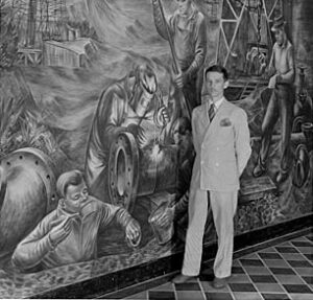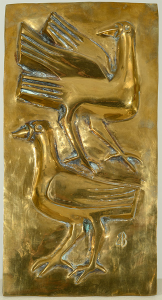
Biography
Edgar Britton was born in Kearney, NE. He enrolled in Dental School at the University of Iowa before dropping out to work as Grant Wood's assistant (1920-1924). He later attended the University of Kansas, where his instructors included the Karl Mattern, a watercolorist, and Albert Bloch, known as the "American Blue Rider" for his association in Germany with Wassily Kandinsky and Franz Marc.
Britton moved to Chicago in 1925 and painted a number of murals throughout the 1930s. Sites included schools in Highland Park, IL (1934), Chicago Heights, IL (1936) and Chicago (1937); post offices in East Moline, IL (1936), Decatur, IL (1938) and Waterloo, IA (1940); the U.S. Department of Interior (1939); and the University of Illinois Medical Center. From 1940-1941 he directed the mural division of the Illinois Art Project.
Having contracted tuberculosis, he was advised by his doctors to move west. He was briefly in New Mexico and then in Colorado for the rest of his career. His artistic focus in Colorado was on sculpture. He also taught at the Fountain Valley School in Colorado Sprints (1942-1950) and the Colorado Springs Fine Art Center (1943-1950). He was a member of the Fine Arts Commission of Denver from 1967-1971 and served as President of Artists Equity in Colorado Springs.
From three decades, from 1950-1980, Britton was Colorado's most significant and most successful sculptor, with works all over the Denver area. He died in Denver in 1982, and a retrospective of his work was mounted at the Colorado Fine Arts Center in 2001, along with a smaller show at the Coburn Gallery of Colorado College, following which Jane Hilberry published "The Erotic Art of Edgar Britton," which offered a biography of Britton and interpreted his erotic drawings.


Critical Analysis
The style of Britton's murals make them exemplars of what we think of as Depression Era art. The compositions show typical activities of the nation - whether at work or at play. Britton's compositions were simple, with portraits of individual people often very prominent. As such, they made bold statements while interacting readily with the viewer.
The other components of Britton's work were his Colorado sculptures and the paintings and drawings he did over the course of his career. Some of Britton's sculptural work was integrated nicely with the designs of his friend, architect James Sudler.
Murals
- Washington, District of Columbia - Department of The Interior: Petroleum Industry: Distribution
- Washington, District of Columbia - Department of The Interior: Petroleum Industry: Production
- Chicago, Illinois - Lane Tech College Prep High School Lunchroom: Epochs in the History of Man
- Chicago Heights, Illinois - Bloom Township High School: Occupational Studies and Their Application
- Decatur, Illinois - Post Office: Natural Resources of Illinois
- Decatur, Illinois - Post Office: The Development of Illinois
- East Moline, Illinois - Post Office: Early Settlers of Moline along the Mississippi
- Highland Park, Illinois - Highland Park High School: Scenes of Industry
- Waterloo, Iowa - Waterloo Public Library: Exposition
- Waterloo, Iowa - Waterloo Public Library: Holiday
References
- Edgar Britton (ask ART).
- Edgar Britton (Modernism in the New City: Chicago Artists, 1920-1950). Biographical text by Lisa Meyerowitz for an art collection selected by Bernard Friedman.
- Edgar Britton Biography (Annex Galleries).
- Michael Paglia, Mind and Body, Westword April 12 (2001).